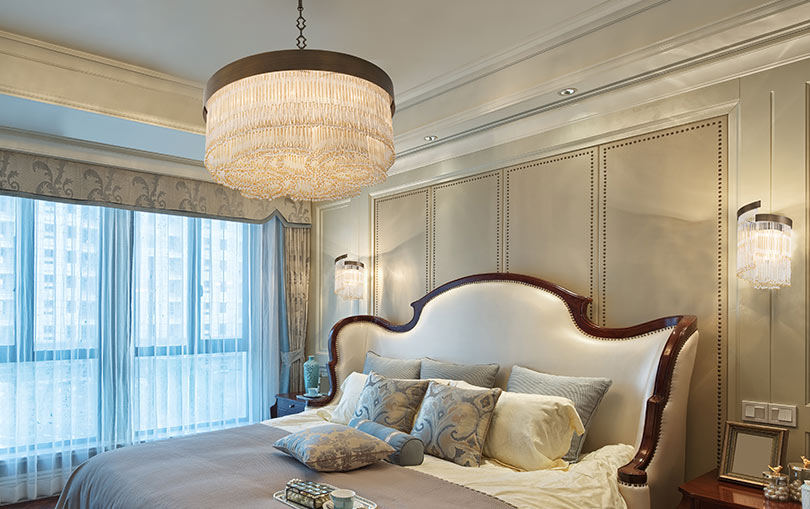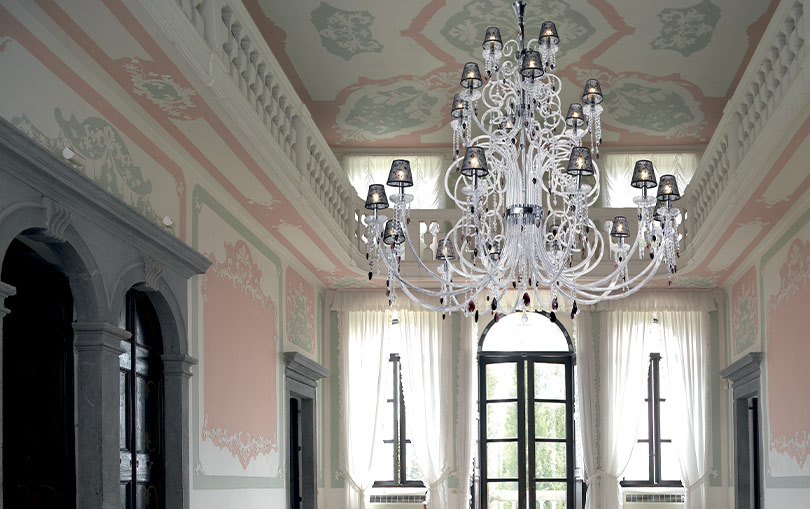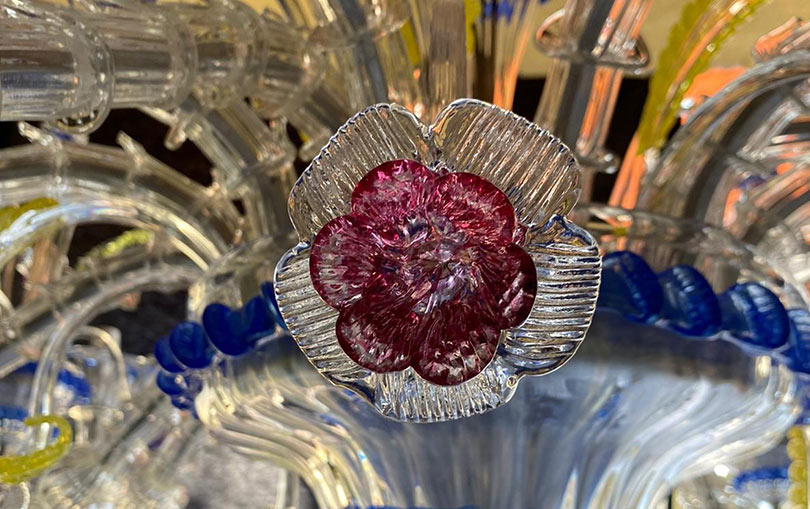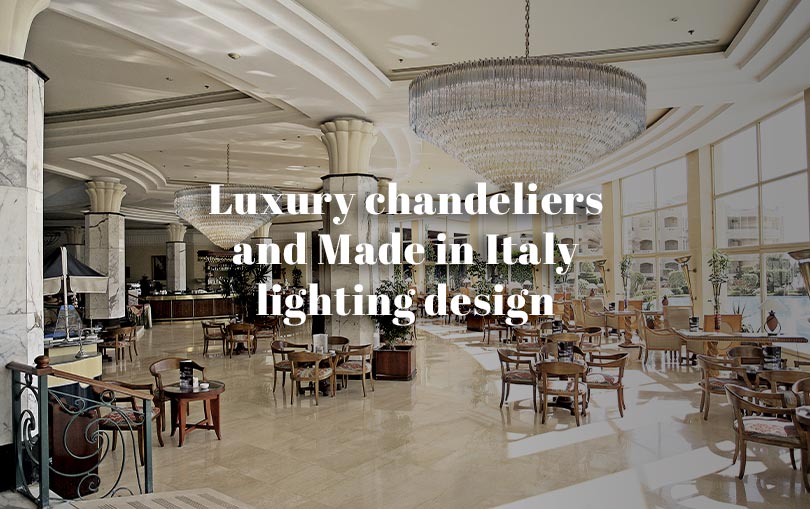LUXURY CHANDELIERS AND MADE IN ITALY LIGHTING DESIGN
MURANO GLASS CHANDELIERS – A SYMBOL OF VENETIAN WEALTH AND LUXURY WORLDWIDE

Made in Italy is synonymous with luxury design and it is one of the sectors of excellence in our country. Among these, Made in Italy luxury chandeliers represent one of the most successful sectors thanks to the sense of aesthetics, quality, uniqueness, design and service, including after-sales.
Made in Italy luxury goods are a world primary and are the result of innovation and craftsmanship.
It is precisely the uniqueness given by the craftsmanship and manual productions that becomes the element of recognition and exclusivity of the product. An enhancement of quality and manual skills that are the trait-d’union between tradition and avant-garde.
Murano glass is one of these excellences, like the Venetian chandeliers in which glass is the protagonist. Luxury chandeliers with surprising effects in terms of workmanship, light refraction and colour. We have already talked about the history of the Venetian chandelier and the Venetian glassmaking techniques; in this article, we will analyse the characteristics of the Venetian chandelier and its colours.
THE VENETIAN CHANDELIER AND ITS CHARACTERISTICS: MURANO GLASS FLOWERS, LEAVES AND CROZIERS

Very few lighting fixtures are as recognisable as the Venetian glass chandelier – a symbol of wealth and refinement all over the world.
In the seventeenth century, the period of maximum splendour of the Maritime Republic, the Venetian gentry, and merchants, eager to demonstrate their strength and wealth, challenged each other to assert their power by surrounding themselves with luxury goods and opulence.
It is during this period, that the Murano glass industry flourished and Venice became the source of talented master glass-makers. Their creations were mainly mirrors, elaborated goblets and tableware – increasingly sophisticated objects to meet the demand of their wealthy clientele. Venetian chandeliers were born in this context and immediately achieved enormous success. Their airy, shimmering, and translucent appearance, the abundance of ornamental elements represented grandeur and opulence.
Today, the change in style trends, as far as luxury furniture is concerned, takes us towards more refined and less opulent tastes in which, however, the rich and opulent design element, which contrasts with a more minimalist and industrial furniture, becomes the object of distinction and exclusivity.
But what are the characterising elements of the Venetian chandelier?
The Venetian chandelier is composed of a central fixture made up of various elements which, in the jargon of the Murano glass furnaces, is called a “basket” or “cage“. This part of the structure includes the rods and is delimited by two panels, a lower one and an upper one. In the “basket”, a central “ornamental garden” is often housed i.e., a set of decorative elements that create fascinating, extremely rich, and voluptuous compositions.
In turn, the “gardens” – also called “stages” – take on different names based on where they are located. Thus, we will have “lateral gardens” (when they are positioned on the rods), “central gardens” (when they are positioned inside the basket), “lower gardens” or “crests”, if grafted onto the central axis of the chandelier.
The other decorative elements of the Venetian chandelier are mainly the following:
- Arms: refer to the part of the chandelier that extends wider from the central support and these are the main light-bearing part of the chandelier as the light bulbs are positioned at their ends.
- Cups: that is, the cup or plate which originally had the task of collecting the wax from the candles and which today, maintains the function of filtering and diffusing the beam of light. There are many different types of cups, including the trefoil cup, bell cup and century cup.
- Shells: small elements in blown glass, measuring a few centimetres, which are inserted into curved metal tubes in order to set up the structure of the chandelier.
- Cornucopias: special shells used in Ca’ Rezzonico chandeliers, larger than the standard ones and very rich and elaborated, often inserted into the arms to fix the pendant with a glass curl.
- Croziers: decorative elements in the shape of a curl to which pendants can be hung
There is also a classic chandelier style, where the lines are simpler and more linear, but always within the Venetian tradition, such as the pendant chandeliers from our Intrecci collection, which offers dining table chandeliers, amazing chandeliers for meeting rooms and large spaces and pendants chandeliers in coloured or clear glass.
In any case, the originality of the Murano glass craftsmanship can be recognised by the glass paste used and by the colours, which are often very bright, with which the components of the chandelier are made – the typical flowers and ornamental rosettes.
HOW THE MURANO GLASS OF THE VENETIAN CHANDELIER IS COLOURED

Murano glass is a perfect material for creating effects with a large variety of colours, different patterns, and multiple shapes.
There are different ways of colouring glass and it is the technique used for colouring that represents one of the main significant indicators of the authenticity of Murano glass.
Indeed, the original Venetian glass is coloured in fire (or colour “in fogo”). This terminology, still in use at Murano glass workshops, indicates the process of colouring molten glass using oxides and mineral salts which, in addition to producing unique and inimitable shades compared to cold colouring, are also decidedly more sustainable.
In the fusion process, the master glassmaker mixes the coloured mineral pigments directly into the glass matrix. This process produces glass of exceptional quality with colour endurance that remains intact, uniform, intense and brilliant.
The fire-coloured glass allows for a surprising refraction of light, creating particular and design atmospheres.
Let’s think, for example, of a ruby-red chandelier in an open space with minimal and mainly tangible furniture or, vice versa, a clear glass chandelier in an environment with coloured walls or, again, a pure gold chandelier combined with contemporary and linear furniture.
But how do you get the colours with the hot molten colouring technique?
- With the addition of metal oxides to the glass mass to give a homogeneous colour.
- With substances in colloidal state, such as colloidal gold to achieve ruby-red glass.
- With particles of colouring materials dispersed in the glass mass, as, for example, in the production of aventurine.
So concretely, which substances are used to achieve the various colours?
Let’s have a look at some together!
Cobalt oxide is used to achieve blue-violet glass, while iron salt and copper can be used for the greenish-blue output.
Ruby-red glass, on the other hand, can be achieved either by adding gold as already mentioned before (the greater the amount of gold used, the more intense the shade of red will be) or by mixing sulphur, cadmium and selenium.
If we want a yellow glass that tends towards brown, we can use iron oxide; if mixed with sulphur, you will get a shade of amber-yellow.
Cobalt and manganese are used together to achieve black glass – a mix, which in different combinations, also produces amethyst purple.
Finally, various components can be used to achieve opaque white glass, including tin. And, of course, the colour is accompanied by the chosen glassmaking technique – a topic that we have already covered in a previous article and to which we refer for further study of the theme.
All of the Murano glass lighting fixtures proposed in the Patrizia Volpato collections are a guarantee of authenticity and craftsmanship of glassmaking.
Discover the magnificence of Venice and the art of glass; discover the magic of Patrizia Volpato luxury chandeliers!


